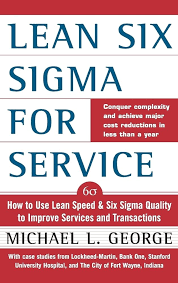Lean Six Sigma is a powerful methodology that has traditionally been applied to manufacturing industries. However, its principles can be equally effective in service industries to improve efficiency, quality, and customer satisfaction. This white paper will explore the application of Lean Six Sigma in service industries, highlighting key concepts, tools, and case studies.
Lean Six Sigma for Service Industries: A Comprehensive Guide
Introduction
Lean Six Sigma is a powerful methodology that has traditionally been applied to manufacturing industries. However, its principles can be equally effective in service industries to improve efficiency, quality, and customer satisfaction. This white paper will explore the application of Lean Six Sigma in service industries, highlighting key concepts, tools, and case studies.
Core Concepts of Lean Six Sigma
Lean:
- Value Stream Mapping: Visualizing the flow of value and identifying waste.
- 5S: Organizing the workplace to improve efficiency and reduce errors.
- Just-In-Time (JIT): Delivering products or services exactly when needed, minimizing waste and inventory.
- Pull System: Producing only what is needed, based on customer demand.
Six Sigma:
- DMAIC Cycle: A five-step process for improvement: Define, Measure, Analyze, Improve, Control.
- Statistical Tools: Using statistical methods to analyze data and identify root causes.
- Six Sigma Belts: Different levels of certification, from White Belt to Black Belt.
Applying Lean Six Sigma in Service Industries
Service industries, such as healthcare, banking, and hospitality, can benefit significantly from Lean Six Sigma. Here are some key applications:
1. Process Improvement:
- Identify Value-Added Steps: Focus on activities that directly contribute to customer satisfaction.
- Eliminate Waste: Reduce non-value-added activities like excessive waiting, rework, and unnecessary motion.
- Optimize Process Flow: Streamline processes to improve efficiency and reduce cycle time.
2. Quality Improvement:
- Define Quality Metrics: Establish clear and measurable quality standards.
- Measure Performance: Use statistical tools to monitor key performance indicators (KPIs).
- Analyze Root Causes: Identify the underlying causes of defects or errors.
- Implement Corrective Actions: Take steps to eliminate root causes and prevent recurrence.
3. Customer Satisfaction:
- Understand Customer Needs: Gather feedback from customers to identify their expectations.
- Prioritize Customer Requirements: Focus on the most critical customer needs.
- Deliver Exceptional Service: Train employees to provide excellent customer service.
- Measure Customer Satisfaction: Use surveys and feedback mechanisms to track customer satisfaction.
Case Studies
- Healthcare: Reducing wait times in emergency rooms, improving patient satisfaction, and reducing medical errors.
- Banking: Streamlining loan processing, improving customer service, and reducing operational costs.
- Hospitality: Enhancing guest experiences, optimizing room turnover, and reducing energy consumption.
Challenges and Best Practices
- Intangibility of Services: Difficulty in measuring and analyzing service processes.
- Customer Variability: Managing diverse customer needs and expectations.
- Employee Engagement: Motivating employees to embrace Lean Six Sigma principles.
- Cultural Change: Overcoming resistance to change and fostering a culture of continuous improvement.
Best Practices:
- Top-Management Support: Strong leadership commitment is essential for successful implementation.
- Employee Involvement: Empower employees to identify and implement improvements.
- Data-Driven Decision Making: Use data to make informed decisions.
- Pilot Projects: Start with small-scale projects to gain experience and build momentum.
- Continuous Improvement: Make Lean Six Sigma a part of the organization's culture.
Conclusion
Lean Six Sigma offers a powerful framework for improving service delivery. By focusing on customer needs, eliminating waste, and optimizing processes, service organizations can achieve significant benefits, including increased efficiency, reduced costs, and enhanced customer satisfaction.
References
- Womack, J. P., & Jones, D. T. (2011). Lean Thinking: Banish Waste and Create Wealth in Your Corporation. Simon & Schuster.
- Harry, M. J., & Schroeder, R. G. (2000). Six Sigma: A Breakthrough Strategy. McGraw-Hill.
- Antony, J. (2014). Lean Six Sigma for Service Industries. CRC Press.
Would you like to delve deeper into a specific aspect of Lean Six Sigma or explore a particular service industry application?
